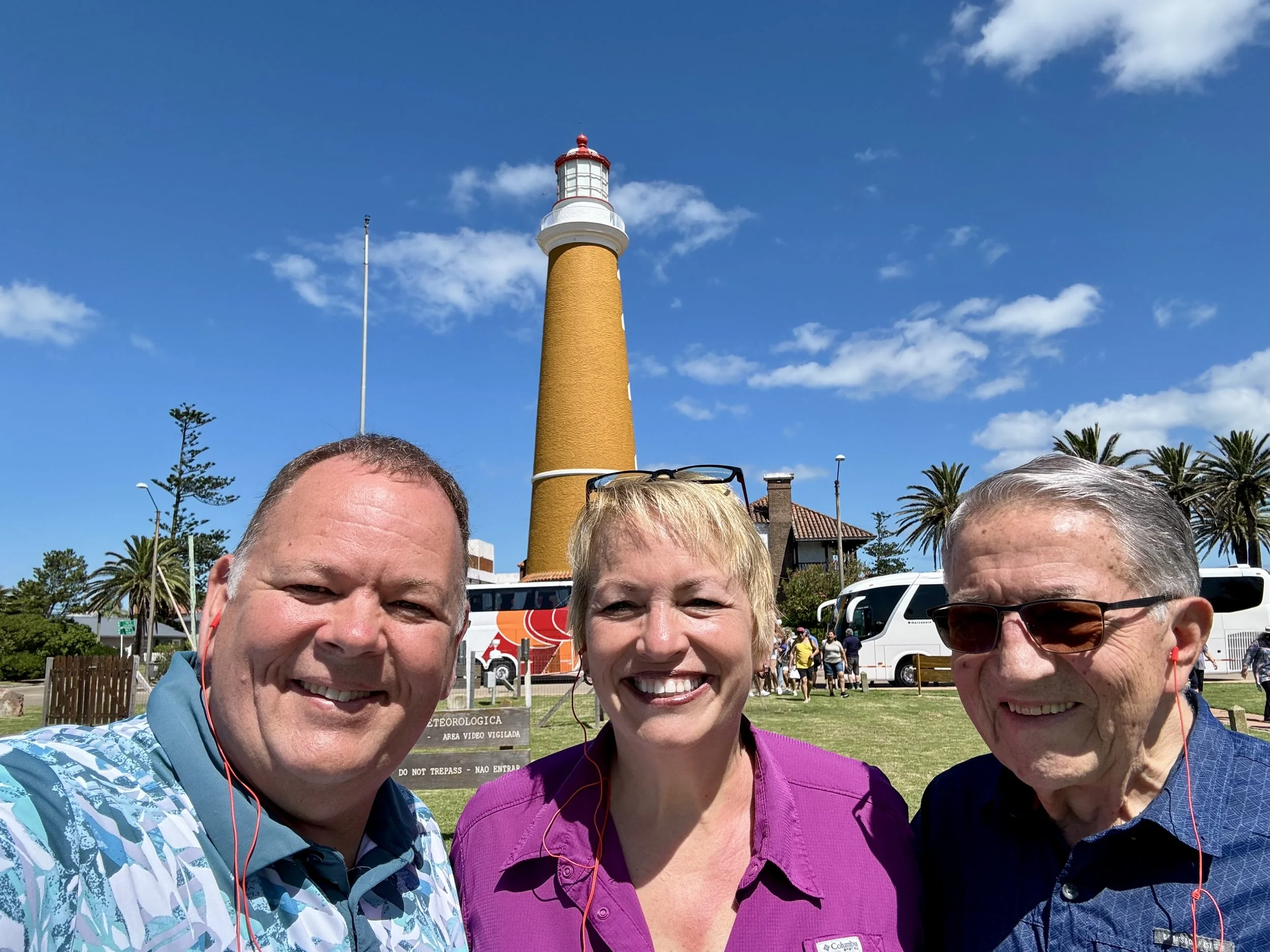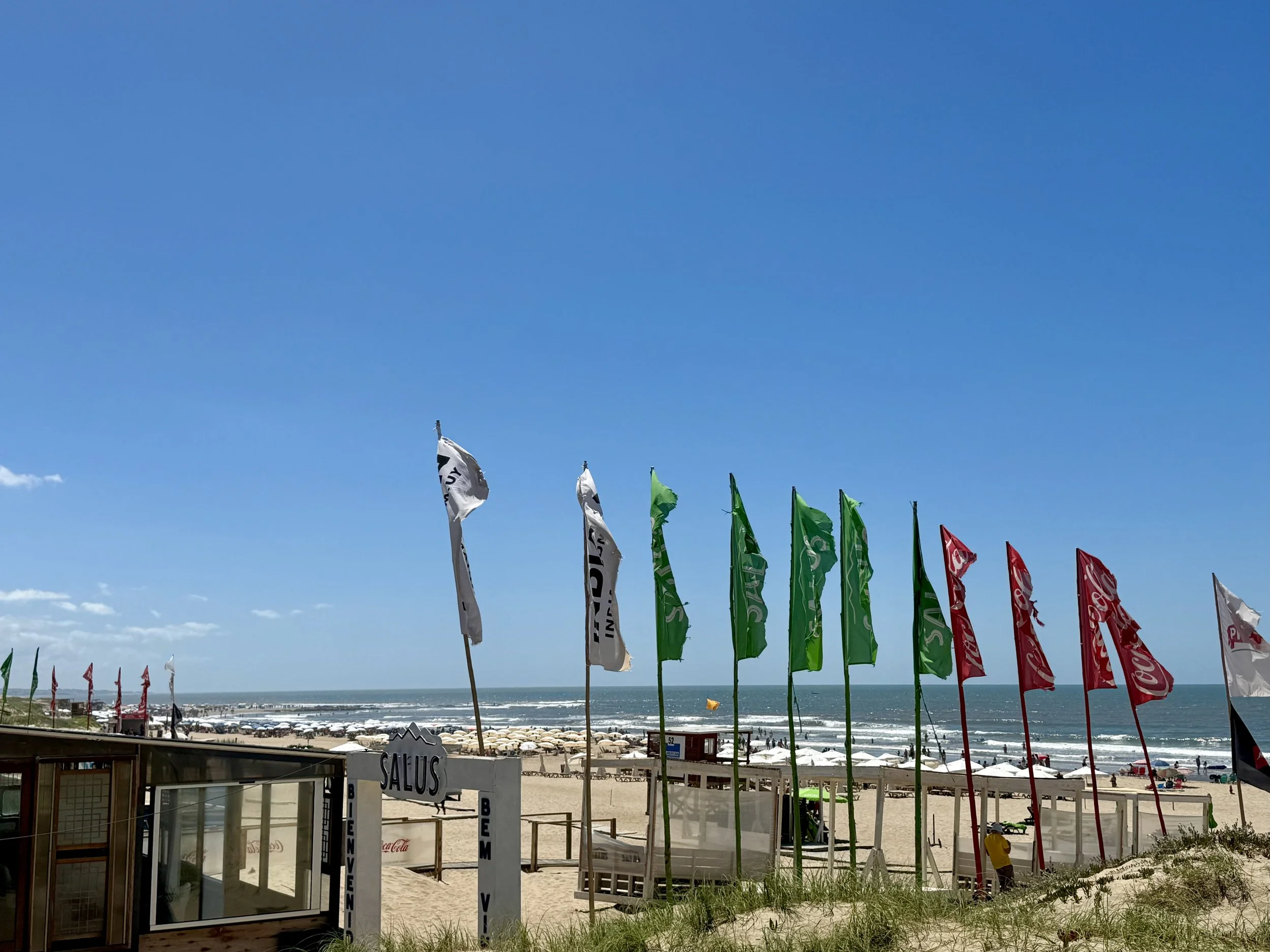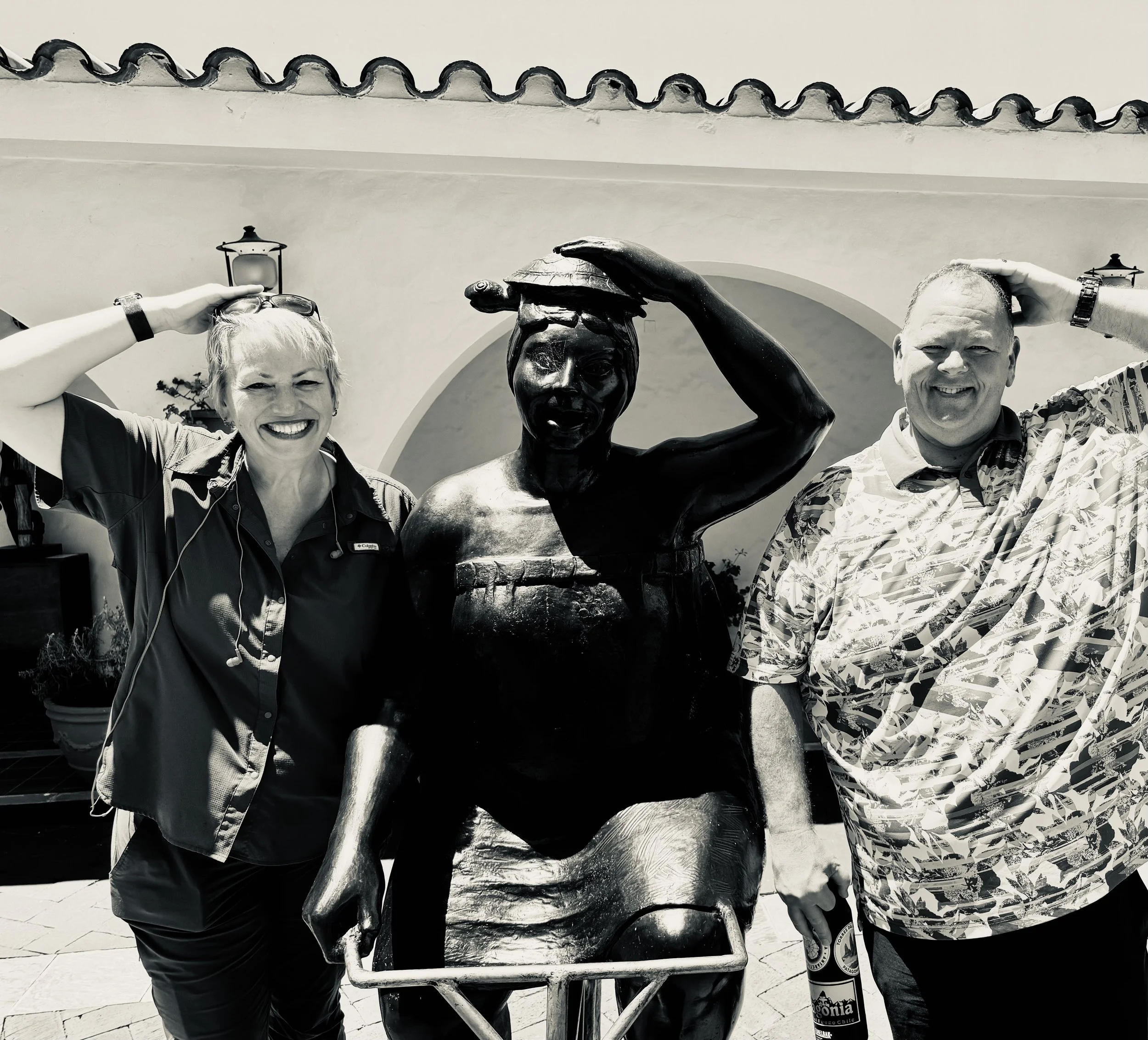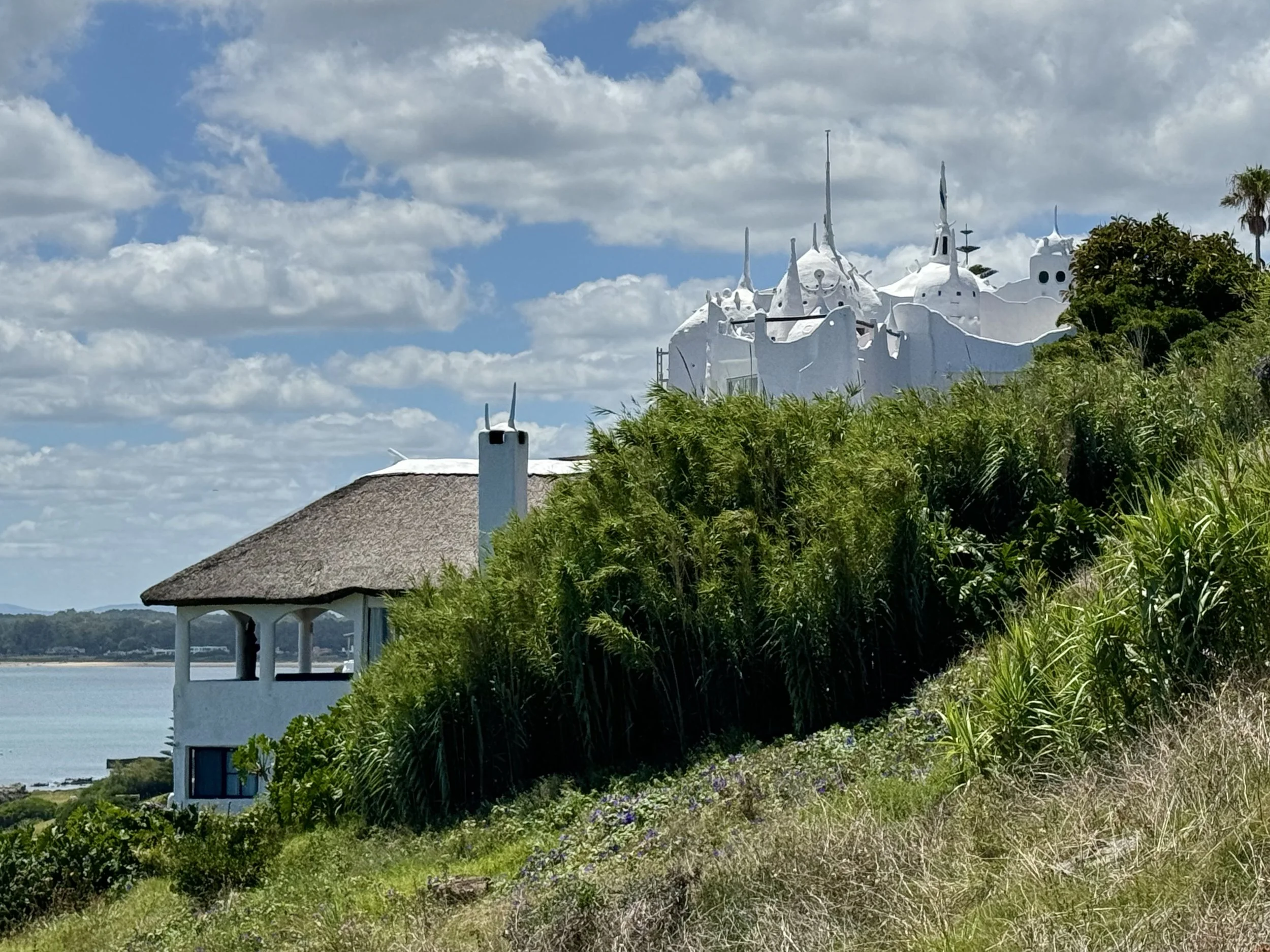Punta Del Este, Uruguay. The Riviera of South America.
Temperature: High 81 degrees, Low 67 degrees.
Punta del Este is Uruguay’s most popular resort destination. We learned via our day-long excursion here that its iconic cityscape, glamorous parties, and incredible beaches attract visitors from all over the world. For many affluent Latin Americans, there is no more sought-after destination than Punta del Este. We certainly new it was different when we navigated into the tiny port via our ship’s lifeboats and navigated through dozens, if not hundreds of what would qualify as yachts and if not yacht’s, then ritzy speedboats.
Uruguay is one of the safest (and most private) countries in Latin America, and Punta del Este is one of the safest cities in the country (Uruguay has the 2nd least corruption in South America behind Chilé. Apparently in high season, it’s a haven for celebrities looking for quality beach time away from the paparazzi. Different from upcoming Buenos Aires, Argentina, this was not a place where you couldn’t help being suspicious when walking at night or watching your back or those of every family member during the day. Just not the case in Punta del Este.
I would also say, as a takeaway, but sharing up front here, that this is not a sleepy retirement resort destination. I’ll cover through the post what we learned, and saw first-hand… but this is a cosmopolitan, high-end vibrant nightlife (think LA/Hollywood style VIP parties everywhere during their Dec/Jan high season), with world-class cuisine, renowned fashion boutiques, and many art museums and exhibiting locations.
Our first stop is walking distance from the pier which is the port lighthouse.
Opposite the light house is the Iglesia de la Candelaria known as the blue church and was simple, beautiful, and virgin white throughout the inside.
After this short stop we begin our trek to the end of the peninsula with a full view of coastal Punta Del Este and there are non-stop beach’s, resorts, and bars as we travel. And they are packed, in every direction. This is the end of the high season so I guess they should be packed. But, everything looks FUN.
The most famous beaches in Punta del Este, Playa Mansa (calm beach) and Playa Brava (turbulent beach), at each side of the peninsula and we are passing Playa Mansa in the images below. Playa Brava on the other side and we won’t make it there but is renowned for surfing.
Interestingly, different from anywhere else we traveled on the West coast of South America, and the East coast of the country to date, there were major branded beach bars, beach clubs, etc. These were just two below, of the dozen+ we passed.
As we continue, we come across what is now the most famous landmark in Punta Del Este ‘La Mano.’ This is a sculpture by Chilean artist Mario Irarrázabal. It depicts five human fingers partially emerging from sand and is located on Parada 1 at Brava Beach. It is also known as either Los Dedos, or Hombre Emergiendo a la Vida. In English, its popular name is The Hand. It has become a symbol for Punta del Este since its completion in February 1982.
Which fingers are they? All from one hand? Lucas any thoughts?
Across the street from The Hand I captured one of the hundreds of huge resorts along this bay.
Dulcé de Leché
At the small gift shop here, Trina bought me the most amazing jar of Dulce de Leche after a local came in and bee-lined straight to it and bought two of them and seem to know the people behind the register. Her intuition was ON. We saw Dulce de Leche ‘everything’ at every corner and store and bakery throughout Uruguay and Argentina. While I didn’t get a picture of the jar, I loved the art on the bag it was in (left).
Our next stop was Museo Ralli. The Ralli Punta del Este Museum, opened in 1988, is located in the center of the residential neighborhood of Beverly Hills, surrounded by a beautiful tree-lined park on its property where architecture and nature merge. The most prized item on exhibit was a sculpture by Salvador Dali which I share below. But, it was the many ‘Beverly Hills’ style homes surrounding the museum I found most interesting. I couldn’t capture those homes through the windows of our transportation but they were stunning homes to rival those in our own West Coast Beverly Hills.
If you’re interested in seeing some of the artwork, and sculptures inside, I’ve curated the most interesting pieces in the group below (you can click into that gallery and easily scroll through).
A few of my favorites from the museum:
Original Salvador Dalí sculpture (above).
Original TnT living museum display (above).
We now make our way to the end of the peninsula. Our first stop is at Casapueblo which unfortunately, since we had a tour guide on their very first day, I didn’t learn enough about it while I was there but did after leaving. It has a fascinating history and the manner of creation, the artist behind it, and it’s connection to nature, and the sun, plus it’s daily rituals around the sunset… draw me to it. I feel as though I will return at some point, to watch the sunset from his creation.
The artist, Carlos Páez Vilaró, built this over the years, but starting with a tin box. He added on as friends came to visit over the years. I was struck by how influenced he was by his early trips to Europe, and meeting artists like Picasso, and Calder. He was apparently highly encouraged to start in ceramics after spending time with Picasso in his workshop in the Alps and apparently that early experience impacted him artistically throughout his life.
Here were the first pictures we took when we stopped at this place on the peninsula. When asked what we were looking for, or at, or why we stopped here, outside of the view… we were told that it there was the white hotel to see off to the right. I heard from the new tour guide in the other transport that they were told to go see the ‘white thing.’ And those were our introductions and full information shared by the guides of this magical place I need to return to.
The first image I capture is the beauty of the view along with what of the ‘white thing’ I could capture:
Below is the most I could capture of it.
The westward view was stunning:
The Pioneer.
“Initially Carlos Páez Vilaró built a tin box (top image left), where he stored old doors, windows and materials for the construction of his future house. Then, with the help of friends and fishermen, he created La Pionera (bottom image left) his first wooden atelier. Years later, he began to cover it with cement and model it with his hands, like a large sculpture. He always attached objects brought from his travels to the walls and set aside special places for his memories. Domes, passageways, tunnels and terraces came to life over the years, drawing with immaculate white the phrase of his architecture against the blue of the sky.”
Casapueblo.
This is what I couldn’t see (image to the right). I had to research the artist and location online after the trip to find this image. None of us had any idea this was here. This was the artists home where he added rooms and incorporated his art, and sculptural explorations, and pieces of art he collected from his travels, as friends and family visited, with each facing west, with a view of the sunset.
There are 13 stories and terraces and this creation took over 36 years for the artist in residence to complete. This including a tribute to his son who was one of only 16 survivors of flight 571 of the Uruguayan Air Force plane crash, which crashed in the Andes on October 13, 1972.
“The painter’s defensive arsenal is fed by the pictures he has painted, since they contain all this truths and his most intimate sensations.”
Still today, on this property, there is a sun ceremony, every day, beginning the 15 minutes before sunset. If you so desire, the poem that I believe is read during every ceremony, written by the Carlos Páez Vilaró, can be found by clicking on the image below which is a sunset from that location, I pulled from their sun ceremony site.
I would have fought to have visited this place had I known, when we were there, what it was, and who the artist was, behind it. So now, I’ll just have to go back.
As I turn, and walk over the hill to the opposite side, facing eastward, I see the coast of Punta del Este, and our ship sitting in its bay. I capture the images, and video below.
We head back into town and seek out some of these culinary highlights that everyone was promoting to us as we explored the area. We landed on a place by the water where we could try milanesa’s and a chivito sandwich, which is a steak sandwich that is considered the country’s national dish. I remember Anthony Bourdain talking about these sandwiches and was described to us as ‘unbelievably flavorful.’ Think steak slices, bacon, ham, eggs, cheese, tomato’s, onions, lettuce.
We found a delightful place, outdoors, but I was underwhelmed by both the milanesa, and the chivito (but still trust Anthony Bourdain 100%!). Considering all the hype, I’ll chalk it up to ‘I must have ordered it wrong’ OR, I chose the wrong spot. All the same, it was a beautiful day with my favorite people, and we loved pretty much everything else.
We still had time to take a jaunt about town on foot after this. We found an incredibly sweet neighborhood bakery that made up for our previous lackluster lunch. I’ve searched everywhere for the name and I recall the location but will have to circle back and add once I get a different local map.
I liked the exterior design of this steakhouse we passed and then Trina noticed the center of the intersection…
NOT MY BEST EFFORT. After that we hunted down the only gift shop we could find open (it’s siesta time in Uruguay) to collect another sticker for our travels. Only as we’re checking out and reading the signage did I realize that we had taken mom and dad into a marijuana novelty museum and gift shop, complete with bountiful free scents. Once I realized, it was a quick… ‘yep, those stickers are GREAT, we’ll take three, and, let’s go.’
As we make our way back down to the pier, I realize we are walking in front of the locally infamous Punta Del Este Yacht Club and it looked as though it had been here a very long time. One stop at their website and you will see they’ve just celebrated 100 years of yachting and this is no casual yacht club.
If all of the flags flying above it wasn’t a hint, the car parked across the street that dad quickly adopted, was a pretty good clue.
I think he secretly wanted this as his one souvenir from the trip. I don’t blame him.
This beauty above is a 1932 Alfa Romeo 6C 1750 Gran Sport which I looked up, and recently at auctions over the last five years have sold for $1.25 to $2.5 million USD on various different auction sites (or, starting at 49,280,687.50 Uruguayan pesos.) I’m with you dad. This would have been a killer souvenir of the trip.
As we are walking back to the pier to catch our lifeboat out to the ship, my only regret is that we didn’t make it over to the artisanal market at the end of Gorlero street. If I understood correctly, it’s huge with like 150-200 artisan stalls which reminded me when I heard about it, of the Portland Saturday Market back home (the longest running, largest artist market in the U.S., approaching 50 years I think). But, we were out of time, and we would have had to hoof it many more blocks, and then I wouldn’t have wanted to leave. So, perhaps, the next trip.
Tomorrow, the capital of Uruguay… Montevideo.













































